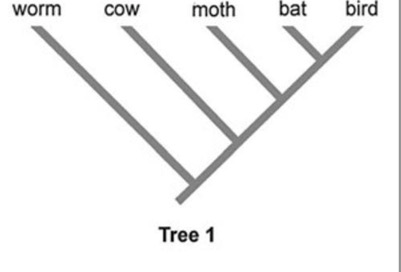A change in allele frequencies of a population is caused by
In a phylogenetic tree, this term refers to the point where two or more branches diverge, representing a common ancestor shared by the descendant taxa.
Node
A key characteristic that separated the human ancestors from the great apes
Bipedalism
This term describes a community of organisms interacting with their physical environment, including both living (biotic) and non-living (abiotic) components.
Ecosystems
In a life table, qx represents the probability of dying within a specific age interval. If a life table provides the following data for a population: l0 = 1000, l1 = 900, l2 = 800, l3 = 700, l4 = 600, and l5 = 500, what is the value of q0 (probability of dying between ages 0 and 1)?
The value of q0 can be calculated as (l0 - l1) / l0. In this case, q0 = (1000 - 900) / 1000 = 0.1.
This theory states that similarities in the genome and molecular phylogenies suggest that we are all related to each other.
Common Descent
This term describes the similarity of traits or characteristics between different organisms due to shared ancestry.
Homology
This 4.5 million years old fossil indicates that the human-chimp common ancestor was not chimp-like and was already walking on both feet.
Ardipithicus ramidus
This term refers to the hierarchical levels in a food chain or food web, representing different positions of organisms based on their source of energy and feeding relationships.
Trophic levels
In a life table, the net reproductive rate (Ro) represents the average number of offspring produced by an individual over their lifetime. If a life table provides the following data for a population: l0 = 1000, l1 = 900, l2 = 800, l3 = 700, l4 = 600, and l5 = 500, what is the value of Ro?
The value of Ro can be calculated as the sum of the product of lx (number of individuals alive at a given age) and mx (age-specific fertility rate) for each age interval. In this case, Ro = (900/1000) * (800/900) * (700/800) * (600/700) * (500/600) = 0.9 * 0.8889 * 0.875 * 0.8571 * 0.8333 = 0.468.
The process by which new species arise from existing ones, often occurring due to geographical isolation or genetic divergence, is known as this.
Speciation
This principle of phylogenetic tree construction states that the tree requiring the fewest evolutionary changes is the most likely representation of the true evolutionary history.
Parsimony
This characteristic unites mammals, reptiles, and bird based on the embryology
Amniotic Sacs
This biome is characterized by extremely cold temperatures, permafrost, and low-growing vegetation such as mosses, lichens, and dwarf shrubs. What is it?
Tundra biome
In an ecosystem, the primary producers convert 10,000 kilocalories (kcal) of energy through photosynthesis. If this energy is then consumed by herbivores, approximately how much energy would be transferred to the next trophic level (carnivores)?
100 kcal
What term describes the type of variation in a population that shows a range of values for a particular trait, with no distinct categories or discrete groups?
Continuous Variation
What is most closely related to Beetles?
Moths and Flies
Two characteristics that humans share with fish during the embryonic state and not in the adult state are
Gil Slits and Tail
In the African savanna, elephants often disturb trees while foraging for food, causing fruits to fall to the ground. The fallen fruits provide a food source for a particular species of small rodents. What type of ecological relationship is demonstrated between the elephants and the small rodents?
Commensalism
A population of rabbits initially consists of 100 individuals. Over a period of 5 years, the population experiences exponential growth with a growth rate (r) of 0.05 per year. Using the exponential growth equation N(t) = N₀e^(rt), calculate the population size (N) after 5 years. Round your answer to the nearest whole number.
128
This type of speciation occurs when a population is geographically separated, leading to reproductive isolation and the formation of new species.
Allopatric Speciation

Which three species form a monophyletic group?
moth, bat, and bird
Cedar Pine are an example of this group because they bear their seeds in cone-like shape
Conifers or Confierophyta
In ecology, this term refers to the full range of environmental conditions and resources that a species can potentially occupy and utilize. What is this concept called?
Fundamental Niche
In a study of a tropical rainforest, a researcher identified the presence of 10 different tree species in a sample plot. The number of individuals for each species is as follows: Species A (50 individuals), Species B (20 individuals), Species C (10 individuals), Species D (5 individuals), Species E (5 individuals), Species F (3 individuals), Species G (2 individuals), Species H (2 individuals), Species I (1 individual), and Species J (1 individual).
Calculate the Shannon Diversity Index (H') for this sample plot. Round your answer to two decimal places.